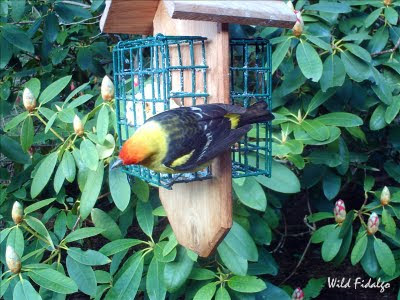Western Tanager
You get a lot of junk photos with a BirdCam. You often end up discarding 80%, and sometimes an entire day's collection of shots is completely useless. These include blanks, blurs, butt shots and birds you have captured 1,000 times already. How many House Finch photos can anyone use? This might even go on for several days. Maybe it's time to change the lure.
Then, once in a while, something special happens that makes it all worthwhile. The photo above was my first glimpse of a Western Tanager (Piranga ludoviciana) at the BirdCam. In fact, it was the first time I had ever seen one. Does an automatic photo count as a sighting? Do you know the feeling of the thrill that will run down the middle of you when something exciting is happening?
The first photo is of a male, and this is the female. It is interesting that I got several shots of this pair on May 14th, then they never appeared again. Apparently they were just passing through and traveling together. They form into pairs where they winter in the tropics or during migration. It would be great to see them again. That would indicate they could be nesting nearby. They breed in open coniferous forests and we can provide that here, but this neighborhood may be too developed for their liking.
The male, here seen with a Chestnut-backed Chickadee (Poecile rufescens), is one of the flashiest birds around. It was chosen as the cover bird for the Western Edition of iBird Explorer, no doubt, because of its colorful beauty. The head feathers are not actually red. This is stain caused by carotenoids acquired and concentrated through its diet of insects. This is also the source of the red or pink colors in House Finches and Flamingos. This begs the question why female House Finches and Tanagers lack the red staining. I assume both males and females share the same diet. There must be something unique about the feathers of the males.
I lived in Iowa for a few years and saw Scarlet Tanagers there. The females of Scarlets and Westerns are very similar. The main difference is white or yellow bars on the wings of the Western females a bit like the Western males. Western Tanagers were first described by Europeans during the Lewis and Clark Expedition, 1803-1806.
May 14, 2011 was a very good day at the BirdCam. I caught some nice photos of a bird I had never seen, both male and female. Apparently they don't normally forage for food this low to the ground, so these may have been very lucky shots. The rhododendron in the background, by the way, is Nova Zembla which is now in full bloom:




